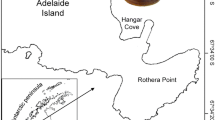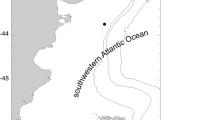Abstract
The protobranch bivalves of the Southern Ocean are poorly understood ecologically, despite their high abundances in soft sediments from the shelf to the deep sea. The subclass has a long evolutionary history predating the formation of the polar front, and knowledge of their reproductive biology is key to understanding better their successful radiation into the Southern Ocean, and within deep-sea basins. In this study, we for the first time investigate the reproductive morphology of three deep-water protobranchs; Yoldiella ecaudata from 500 m in the Amundsen Sea; Y. sabrina from between 200 and 4,730 m in the Amundsen Sea, Scotia Sea, and South Atlantic; and Y. valettei from 1,000 m in the Scotia Sea. All three species demonstrate evidence of lecithotrophic larval development with maximum oocyte size of 130.4, 187.9, and 120.6 µm in Y. ecaudata, Y. sabrina, and Y. valettei, respectively, further supported by prodissoconch I measurements. There is evidence for simultaneous hermaphroditism in Y. valettei. Asynchronous oocyte development within specimens of Y. ecaudata and Y. valettei is described, and also between populations of Y. sabrina separated by depth. The reproductive characteristics, comparable to those of North Atlantic deep-sea protobranch species, are discussed in the context of the cold thermally stable conditions prevailing on the deep-Antarctic continental shelf and deep sea. The requirement for reclassification of this complex subclass is also discussed in relation to observed soft anatomy and shell characteristics.






Similar content being viewed by others
References
Allen JA (1978) Evolution of the deep-sea protobranch bivalves. Phil Trans R Soc B 284:387–401
Allen JA (2008) Bivalvia of the deep Atlantic. Malacologia 50:57–173
Allen JA, Hannah FJ (1986) A reclassification of the recent genera of the subclass Protobranchia (Mollusca: Bivalvia). J Conch 32:225–249
Allen JA, Hannah FJ (1989) Studies on the deep sea Protobranchia (Nuculanidae). Bull Br Mus Nat Hist 55:123–171
Allen JA, Sanders HL (1973) Studies on deep-sea Protobranchia (Bivalvia); the families Siliculidae and Lametilidae. Bull Mus Comp Zool 145:263–310
Allen JA, Sanders HL (1982) Studies on deep-sea Protobranchia (Bivalvia); the subfamily Spinulinae (family Nuculanidae). Bull Mus Comp Zool 145:263–310
Allen JA, Sanders HL (1996) The zoogeography, diversity and origin of the deep-sea protobranch bivalves of the Atlantic: the epilogue. Prog Oceanogr 28:95–153
Allen JA, Sanders HL, Hannah FJ (1995) Studies on the deep-sea Protobranchia (Bivalvia); the subfamily Yoldiellinae. Bull Br Mus Nat Hist 61:11–90
Bosch I, Pearse JS (1988) Seasonal pelagic development and juvenile recruitment of the bivalve Laternula elliptica in McMurdo Sound, Antarctica. Am Zool 28:89
Bosch I, Pearse JS (1990) Developmental types of shallow-water asteroids of McMurdo Sound, Antarctica. Mar Biol 104:41–46
Brandt A, Barthel D (1995) An improved supra- and epibenthic sledge for catching Peracarida (Crustacea, Malacostraca). Ophelia 43:15–23
Brente N (2005) An epibenthic sledge for operations on Marine Soft Bottom and Bedrock. Mar Tech Soc J 39:10–21
Brey T, Hain S (1992) Growth, reproduction and production of Lissarca notorcadensis (Bivalvia: Philobryidae) in the Weddell Sea, Antarctica. Mar Ecol Prog Ser 82:219–226
Chase MR, Etter RJ, Rex MA, Quattro JM (1998) Bathymetric patterns of genetic variation in a deep-sea protobranch bivalve Deminucula atacellana. Mar Biol 131:301–308
Convey P, Stevens MI, Hodgson DA, Smellie JL, Hillenbrand C-D, Barnes DKA, Clarke A, Pugh PJA, Linse K, Cary SC (2009) Exploring biological constraints on the glacial history of Antarctica. Quat Sci Rev 28:3035–3048
Davenport J (1988) The feeding mechanism of Yoldia (= Aequiyoldia) eightsi (Courthouy). Proc R Soc B 232:431–442
Enderlein P, Larter R (2008) JR179/BIOPEARL II Cruise Report. www.bodc.ac.uk/data/information_and_inventories/cruise_inventory/report/8277
Etter RJ, Rex MA, Chase MR, Quattro JM (2005) Population differentiation decreases with depth in deep-sea bivalves. Evolution 59:1479–1491
Etter RJ, Boyle EE, Glazier A, Jennings RM, Dutra E, Chase MR (2011) Phylogeography of a pan-Atlantic abyssal protobranch bivalve: implications for evolution in the Deep Atlantic. Mol Ecol 20:829–843
Fahrbach E (2005) The expedition ANTARKTIS-XXII/3 of the Research Vessel “Polarstern” in 2005. Berichte Polar Meeresforsch 533:1–246
Gage JD (1994) Recruitment ecology and age structure of deep-sea invertebrate populations. In: Young CM et al (eds) Reproduction, larval biology and recruitment of the deep-sea benthos. pp 223–242
Gage JD, Tyler PA (1991) Deep-sea biology: a natural history of organisms at the deep-sea floor. Cambridge University Press, Cambridge
Glover AG, Smith CR, Mincks SL, Sumida PYG, Thurber AR (2008) Macrofaunal abundance and composition on the West Antarctic Peninsula continental shelf: evidence for a sediment ‘food bank’ and similarities to deep-sea habitats. Deep-Sea Res Part II 55:2491–2501
Gofas, S (2012) Yoldiella A. E. Verrill & Bush, 1897 Accessed through: World Register of Marine Species at http://www.marinespecies.org/aphia.php?p=taxdetails&id=138673 on 2012-03-07
Goodsell JG, Eversole AG (1992) Prodissoconch I and II length in Mercenaria taxa. Nautilus 106:119–122
Gustafson RG, Reid RGB (1986) Development of the pericalymma larva of Solemya reidi (Bivalvia: Cryptodonta: Solemyidae) as revealed by light and electron microscopy. Mar Biol 93:411–427
Hain S, Arnaud PM (1992) Notes on the reproduction of high-Antarctic molluscs from the Weddell Sea. Polar Biol 12:303–312
Higgs ND, Reed AJ, Hooke R, Honey DJ, Heilmayer O, Thatje S (2009) Growth and reproduction in the Antarctic brooding bivalve Adacnarca nitens (Philobryidae) from the Ross Sea. Mar Biol 156:1073–1081
Huybrechts P (2002) Sea-level changes at the LGM from ice-dynamic reconstructions of the Greenland and Antarctic ice sheets during the glacial cycles. Quart Sci Rev 21:203–231
Killeen IJ, Turner J (2009) Yoldiella and Portlandia (Bivalvia) from the Faroe-Shetland Channel and Rockall Trough, Northeast Atlantic. J Conch 39:733–778
Knudsen J (1970) The systematics and biology of abyssal and hadal Bivalvia. Galathea Rep 11:1–241
Lightfoot RH, Tyler PA, Gage JD (1979) Seasonal reproduction in deep-sea bivalves and brittlestars. Deep-Sea Res 26A:967–973
Linse K (2006) Cruise Report; JR144, JR145, JR146, JR147 and JR149. www.bodc.ac.uk/data/information_and_inventories/cruise_inventory/report/jr144-149.pdf
Linse K, Cope T, Lörz AN, Sands C (2007) Is the Scotia Sea a centre of Antarctic marine diversification? Some evidence of cryptic speciation in the circum-Antarctic bivalve Lissarca notorcadensis (Arcoidea: Philobryidae). Polar Biol 30:1059–1068
McClain CR, Stegan JC, Hurlbert AH (2012) Dispersal, environmental niches and oceanic-scale turnover in deep-sea bivalves. Proc R Soc B 279:1993–2002
Mincks SL, Smith CR, De Master DJ (2005) Persistence of labile organic matter and microbial biomass in Antarctic shelf sediments: evidence of a sediment ‘food bank’. Mar Ecol Prog Ser 300:3–19
Nolan CP, Clarke A (1993) Growth in the bivalve Yoldia eightsi at Signy Island, Antarctica, determined from internal shell increments and calcium-45 incorporation. Mar Biol 117:243–250
Ockelmann KW (1965) Developmental types in marine bivalves and their distribution along the Atlantic coast of Europe. In: Peake J (eds) Proceedings of the first European malacological congress, London, 1962, pp 25–35
Passos FD, Domaneschi O (2009) The anatomical characters related to the brooding behavior of two Antarctic species of Mysella Angas, 1877 (Bivalvia, Galeommatoidea, Lasaeidae), with direct and indirect evidences of ovoviviparity. Polar Biol 32:271–280
Peck LS, Bullough LW (1993) Growth and population structure in the infaunal bivalve Yoldia eightsii in relation to iceberg activity at Signy Island, Antarctica. Mar Biol 117:235–241
Peck LS, Colman JG, Murray AWA (2000) Growth and tissue mass cycles in the infaunal bivalve Yoldia eightsii at Signy Island, Antarctica. Polar Biol 23:420–428
Peck LS, Webb KE, Bailey DM (2004) Extreme sensitivity of biological function to temperature in Antarctic marine species. Funct Ecol 18:625–630
Picken GB (1979) Non-pelagic reproduction of some Antarctic prosobranch gastropods from Signy Island, South Orkney Islands. Malacologia 19:109–128
Picken GB (1980) Reproductive adaptations of Antarctic benthic invertebrates. Biol J Linn Soc 14:67–75
Prezant RS, Showers M, Winstead RL, Cleveland C (1992) Reproductive ecology of the Antarctic bivalve Lissarca notorcadensis (Philobryidae). Am Malacol Bull 9:173–186
Reed AJ, Morris JP, Linse K, Thatje S (2013a) Plasticity in shell morphology and growth among deep-sea protobranch bivalves of the genus Yoldiella (Yoldiidae) from contrasting Southern Ocean regions. Deep-Sea Res Part I 81:14–24
Reed AJ, Thatje S, Linse K (2013b) An unusual hermaphrodite reproductive trait in the Antarctic brooding bivalve Lissarca miliaris from the Scotia Sea, Southern Ocean. Polar Biol 36:1–11
Reed AJ, Linse K, Thatje S (2014) Differential adaptations between cold-stenothermal environments in the bivalve Lissarca cf. miliaris (Philobryidae) from the Scotia Sea islands and Antarctic Peninsula. J Sea Res 88:11–20
Richardson MG (1979) The ecology and reproduction of the brooding Antarctic bivalve Lissarca miliaris. Br Antarct Surv Bull 49:91–115
Sanders HL, Hessler RR, Hampson GR (1965) An introduction to the study of deep-sea benthic faunal assemblages along the Gay Head-Bermuda transect. Deep-Sea Res 12:845–867
Sartori AF, Domaneschi O (2005) The functional morphology of the Antarctic bivalve Thracia meridionalis Smith, 1885 (Anomalodesmata: Thraciidae). J Molluscan Stud 71:199–210
Scheltema RS, Williams IP (2009) Reproduction among protobranch bivalves of the family Nuculidae from sublittoral, bathyal, and abyssal depths off the New England coast of North America. Deep-Sea Res Part II 56:1835–1846
Sharma PP, Zardus JD, Boyle EE, González VL, Jennings RM, McIntyre E, Wheeler WC, Etter RJ, Giribet G (2013) Into the deep: a phylogenetic approach to the bivalve subclass Protobranchia. Mol Phylogenet Evol 69:188–204
Shilling FM, Manahan DT (1994) Energy metabolism and amino acid transport during early development of Antarctic and temperate echinoderms. Biol Bull 187:398–407
Thatje S (2012) Effects of capability for dispersal on the evolution of diversity in Antarctic benthos. Integr Comp Biol 52:470–482
Thatje S, Hillenbrand CD, Larter R (2005) On the origin of Antarctic marine benthic community structure. Trends Ecol Evol 20:534–540
Thatje S, Hillenbrand CD, Mackensen A, Larter R (2008) Life hung by a thread: endurance of Antarctic fauna in glacial periods. Ecology 89:682–692
Turekian KK, Cochran JK, Kharkar DP, Cerrato RM, Vaišnys JR, Sanders HL, Grassle JF, Allen JA (1975) Slow growth rate of a deep-sea clam determined by 228Ra chronology. Proc Natl Acad Sci 72:2829–2832
Tyler PA, Harvey R, Giles LA, Gage JD (1992) Reproductive strategies and diet in deep-sea nuculanid protobranchs (Bivalvia: Nucloidea) from the Rockall Trough. Mar Biol 114:571–580
Verrill AE, Bush KJ (1898) Revision of the deep water Mollusca of the Atlantic Coast of North America with descriptions of new genera and species. Part 1—Bivalvia. Proc US Nat Mus 20:775–901
Zardus JD (2002) Protobranch Bivalves. Adv Mar Biol 42:1–65
Zardus JD, Martel AL (2001) Phylum Mollusca: Bivalvia. In: Young CM, Sewell MA, Rice ME (eds) Atlas of marine invertebrate larvae. Academic Press, London, pp 289–325
Zardus JD, Morse MP (1998) Embryogenesis, morphology and ultrastructure of the pericalymma larva of Acila castrensis (Bivalvia: Protobranchia: Nuculoida). Invert Biol 117:221–244
Zardus JD, Etter RJ, Chase MR, Rex MA, Boyle EE (2006) Bathymetric and geographic populations in the pan-Atlantic deep-sea bivalve Deminucula atacellana. Mol Ecol 15:639–651
Acknowledgments
Adam J. Reed was supported through a Natural Environment Research Council PhD studentship. We are grateful to the cruise leaders, captains, officers, and crews of PFS Polarstern (ANDEEP III) and of RRS James Clark Ross (JR144 BIOPEARL I, JR179 BIOPEARL II) who enabled us to collect the samples for this study. We thank Richard Pearce for help with SEM analysis, and Paul Tyler and John Grahame for their feedback on an earlier version of this manuscript. The authors would also like to thank Danja Hoehn for contributing to early thoughts and discussions on protobranch reproduction. This study is part of the British Antarctic Survey Polar Science for Planet Earth Programme funded by The Natural Environment Research Council (NERC), and is ANDEEP publication #192.
Author information
Authors and Affiliations
Corresponding author
Rights and permissions
About this article
Cite this article
Reed, A.J., Morris, J.P., Linse, K. et al. Reproductive morphology of the deep-sea protobranch bivalves Yoldiella ecaudata, Yoldiella sabrina, and Yoldiella valettei (Yoldiidae) from the Southern Ocean. Polar Biol 37, 1383–1392 (2014). https://doi.org/10.1007/s00300-014-1528-4
Received:
Revised:
Accepted:
Published:
Issue Date:
DOI: https://doi.org/10.1007/s00300-014-1528-4




